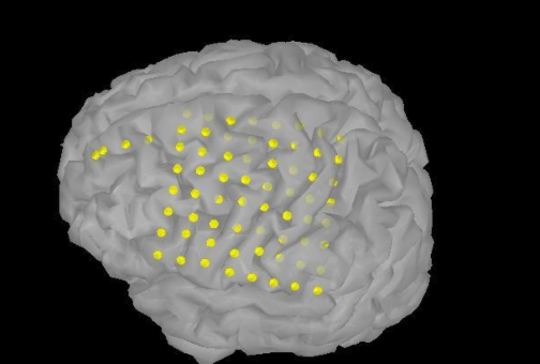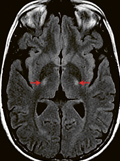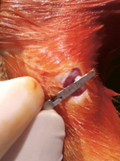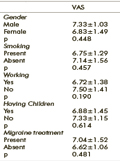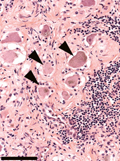The eLitMed.hu medical portal uses computer cookies for convenient operation. Detailed information can be found in the Cookie-policy.
Clinical Neuroscience - 2020;73(03-04)
Content
[Intracranial EEG monitoring methods]
[Resective surgery is considered to be the best option towards achieving seizure-free state in drug-resistant epilepsy. Intracranial EEG (iEEG) is necessary if the seizure-onset zone is localized near to an eloquent cortical area, or if the results of presurgical examinations are discordant, or if an extratemporal epilepsy patient is MRI-negative. Nowadays, 3 kinds of electrodes are used: (1) foramen ovale (FO) electrodes; (2) subdural strip or grid electrodes (SDG); (3) deep electrodes (stereo-electroencephalographia, SEEG). The usage of FO electrode is limited to bitemporal cases. SDG and SEEG have a distinct philosophical approach, different advantages and disadvantages. SDG is appropriate for localizing seizure-onset zones on hemispherial or interhemispherial surfaces; it is preferable if the seizure-onset zone is near to an eloquent cortical area. SEEG is excellent in exploration of deeper cortical structures (depths of cortical sulci, amygdala, hippocampus), although a very precise planning is required because of the low spatial sampling. The chance for seizure-freedom is relatively high performing both methods (SDG: 55%, SEEG: 64%), beside a tolerable rate of complications.]
[Diseases with peripheral motor symptoms ]
[Diseases with peripheral motor symptoms are a rare, but important subgroup of the all peripheral neuropathies, radiculopathies and neuronopathies. In these mostly progressive neuropathies, the clinical features include pure motor symptoms with weakness and wasting of the striated muscles. The differentiation of these diseases is frequently a challenge for qualified clinical neurologists. A careful history taking, the disease time course, the findings of routine clinical physical examination and the electrophysiological studies are all necessary in the diagnostic procedure. The aim of this publication is to overview the clinical characteristics of the pure motor peripheral neuropathies, to consider the diagnostic steps and the differential diagnosis, and finally to summarize the treatment options. ]
[New applications of conventional EEG analysis ]
[Neurophysiological research suggests that the so-called “standard” EEG analysis has been confronted with new diagnostic challenges. The findings mainly concern the occurrence, the neurophysiological and clinical significance of epileptiform EEG discharges in several neurological and psychiatric disorders. In addition to well-known interictal and ictal discharges, a growing number of recently recognized epileptiform phenomena have been described. The first reports suggested that they might be relevant for the comprehensive description of epileptic dysfunction and might contribute to diagnosis and treatment as well. However, considerable improvement of present-day “standard” EEG technique is necessary to give an appropriate answer to most challenges. Reliable registration and quantitative assessment of well-known epileptiform transients require extended electrode coverage of the head (high-density EEG) and long-term recordings including waking and sleep states to estimate frequency and dynamics of targeted activities. Computer-based automatic event detection is preferable to spare time and cost of the evaluation. The authors review recent progress concerning epidemiology, neurophysiology and clinical impact of well-known epileptiform transients and candidate epileptiform activities in neurological and psychiatric conditions. However, recent results need confirmation in large patient populations; therefore, research should not be restricted to a few central laboratories.]
Cyanocobalamin and cholecalciferol synergistically improve functional and histopathological nerve healing in experimental rat model
Introduction - Peripheral nerve injury (PNI) is a frequent problem among young adults. Hopefully, regeneration can occur in PNI unlike central nervous system. If nerve cut is complete, gold standard treatment is surgery, but incomplete cuts have been tried to be treated by medicines. The aim of the study was to evaluate and compare clinical and histopathological outcomes of independent treatment of each of Vitamin B12 (B12) and Vitamin D3 (D3) and their combination on sciatic nerve injury in an experimental rat model. Materials and methods - Experimental animal study was performed after the approval of BEH Ethics Committee No. 2015/10. 32 rats were grouped into four (n=8) according to treatment procedures, such as Group 1 (controls with no treatment), Group 2 (intraperitoneal 1 mg/kg/day B12), Group 3 (oral 3500 IU/kg/week D3), Group 4 (intraperitoneal 1 mg/kg/day B12+ oral 3500 IU/kg/week D3). Sciatic Functional Index (SFI) and histopathological analysis were performed. Results - SFIs of Group 2, 3, 4 were statistically significantly higher than controls. Group 2 and 3 were statistically not different, however Group 4 was statistically significantly higher than others according to SFI. Axonal degeneration (AD) in all treatment groups were statistically significantly lower than in Group 1. AD in Group 4 was significantly lower than in Group 2 and 3; there was no significant difference between Group 2 and 3. There was no significant difference between Group 1,2 and 3 in Axonolysis (A). But A of Group 4 was significantly very much lower than all others. Oedema- inflammation (OE-I) in all treatment groups were significantly lower than in Group 1; there was no significant difference between Group 2 and group 4. OE-I in Group 2 and 4 were significantly lower than in Group 3. There were no significant differences between Group 1, 2 and 3 in damage level scores; score of Group 4 was significantly lower than of Group 1. Conclusions - B12 and D3 were found effective with no statistically significant difference. But combined use of B12 and D3 improve nerve healing synergistically. We recommend combined use of B12 and D3 after PNI as soon as possible.
Effects of valproate, carbamazepine and levetiracetam on Tp-e interval, Tp-e/QT and Tp-e/QTc ratio
Aim - To evaluate P-wave dispersion before and after antiepileptic drug (AED) treatment as well as to investigate the risk of ventricular repolarization using the Tpeak-Tend (Tp-e) interval and Tp-e/QT ratio in patients with epileptic disorder. Methods - A total of 63 patients receiving AED therapy and 35 healthy adults were included. ECG recordings were obtained before and 3 months after anti-epileptic treatment among patients with epilepsy. For both groups, Tp-e and Tp-e/QT ratio were measured using a 12-lead ECG device. Results - Tp-e interval, Tpe/QT and Tp-e/QTc ratios were found to be higher in the patient group than in the control group (p<0.05, for all), while QTmax ratio was significantly lower in the patient group. After 3 months of AED therapy, significant increases in QT max, QTc max, QTcd, Tp-e, Tp-e/QT, and Tp-e/QTc were found among the patients (p<0.05). When the arrhythmic effects of the drugs before and after treatment were compared, especially in the valproic acid group, there were significant increases in Tp-e interval, Tp-e/QT and Tp-e/QTc values after three months of treatment (p<0.05). Carbamazepine and levetiracetam groups were not statistically significant in terms of pre- and post-treatment values. Conclusions - It was concluded that an arrhythmogenic environment may be associated with the disease, and patients who received AED monotherapy may need to be followed up more closely for arrhythmia.
Evaluation of anxiety, depression and marital relationships in patients with migraine
Aim - The aim of this study was to evaluate the frequency and characteristics of attacks in patients with migraine, to determine the effects of anxiety or depressive symptoms, and to evaluate the marital relationships of patients with migraine. Method - Thirty patients who were admitted to the neurology outpatient clinic of our hospital between July 2018 and October 2018 and were diagnosed with migraine according to the 2013 International Headache Society (IHS) diagnostic criteria were included in this cross-sectional study. Age, sex, headache frequency and severity, depressive traits, marital satisfaction and anxiety status were examined. We used the Beck Depression Inventory (BDI), State-Trait Anxiety Inventory (STAI), Maudsley Marital Questionnaire (MMQ) and Visual Analogue Scale (VAS) for measuring relevant parameters. Results - The mean severity of migraine pain according to VAS scale was 6.93 ± 1.41 and the mean number of migraine attacks was 4.50 ± 4.24. The mean BDI score of the patients was 12.66 ± 8.98, the mean MMQ-M score was 19.80 ± 12.52, the mean MMQ-S score was 13.20 ± 9.53, the mean STAI-state score was 39.93 ± 10.87 and the mean STAI-trait score was 45.73 ± 8.96. No significant correlation was found between age, number of migraine attacks, migraine duration, migraine headache intensity, and BDI, STAI and MMQ scores (p>0.05). But there was a positive correlation between MMQ-S and scores obtained from the BDI and STAI-state scales (p<0.05). Conclusion - In this study more than half of the migraine patients had mild, moderate or severe depression. A positive correlation was found between sexual dissatisfaction and scale scores of depression and anxiety.
To handle the HaNDL syndrome through a case: The syndrome of headache with neurologic deficits and cerebrospinal fluid lymphocytosis
The syndrome of headache with neurologic deficits and cerebrospinal fluid lymphocytosis (HaNDL) is a rare entity. This disease has been related to migrainous headaches. It is a benign, self-limited disorder, which is characterized by fluctuating neurological symptoms and cerebrospinal fluid lymphocytosis. We describe a case of a 47 years old man with acute onset of headache and aphasia. Cerebrospinal fluid analysis revealed a lymphocytic pleocytosis (25 cells/μl, 100% lymphocytes). Electroencephalogram showed moderate slow rhythm in the left hemisphere, with temporoparietal predominance, and without epileptiform activity. His blood tests as well as magnetic resonance imaging (MRI) results were normal. With the diagnosis of HaNDL syndrome the patient was accepted in the Department of Neurology and discharged with full recovery.
CANOMAD syndrome with respiratory failure
CANOMAD (chronic ataxic neuropathy, ophthalmoplegia, M-protein agglutination, disialosyl antibodies) syndrome is a rare polyneuropathy. IgM paraproteins react with ganglioside-containing disialylated epitopes resulting in dorsal root ganglionopathy and B-lymphocyte infiltration of cranial and peripheral nerves. Clinical features include ataxia, slight muscle weakness, areflexia, sensory- and cranial nerve symptoms. Case studies have reported the efficacy of rituximab and intravenous immunoglobulin (IVIg) treatments. We present the case of a 57-year-old man, who had difficulty walking, with numbness and clumsiness in all limbs. He had areflexia, vibratory sensation loss and ataxia. Laboratory tests showed IgM monoclonal components and disialosyl antibodies in the serum. Nerve conduction studies indicated severe sensorimotor demyelinating polyneuroradiculopathy. Despite IVIg and rituximab treatments, the patient’s disease course gradually worsened and he died of respiratory failure. Neuropathological examination revealed dorsal column- and dorsal root atrophy with mixed mononuclear cell infiltration. This article aims to draw attention to this syndrome, and the use of early potent immunosuppressive treatment to improve patients’ quality of life.
1.
Clinical Neuroscience
Is there any difference in mortality rates of atrial fibrillation detected before or after ischemic stroke?2.
Clinical Neuroscience
Factors influencing the level of stigma in Parkinson’s disease in western Turkey3.
Clinical Neuroscience
Neuropathic pain and mood disorders in earthquake survivors with peripheral nerve injuries4.
Journal of Nursing Theory and Practice
[Correlations of Sarcopenia, Frailty, Falls and Social Isolation – A Literature Review in the Light of Swedish Statistics]5.
Clinical Neuroscience
[Comparison of pain intensity measurements among patients with low-back pain]1.
2.
Clinical Neuroscience Proceedings
[A Magyar Stroke Társaság XVIII. Kongresszusa és a Magyar Neuroszonológiai Társaság XV. Konferenciája. Absztraktfüzet]3.
4.
Journal of Nursing Theory and Practice
[A selection of the entries submitted to the literary contest "Honorable mission: the joys and challenges of our profession" ]5.
Journal of Nursing Theory and Practice
[End of Life and Palliative Care of Newborns in the Nursing Context]